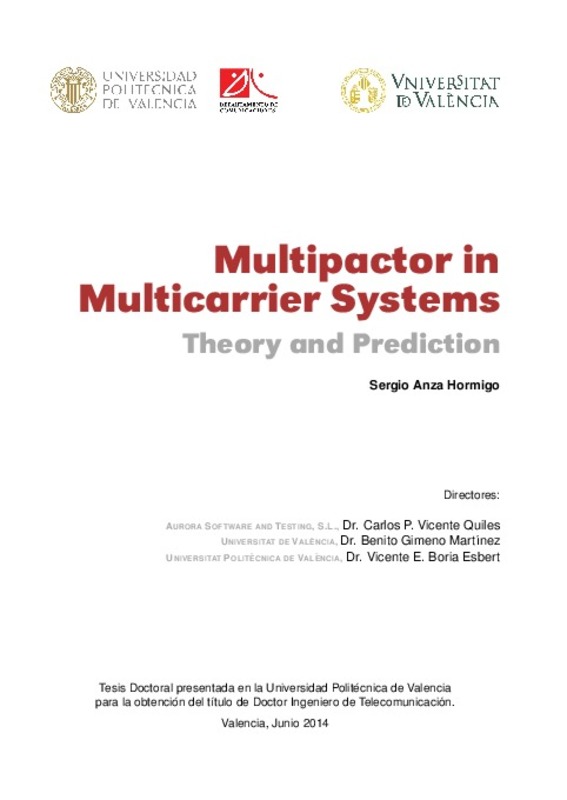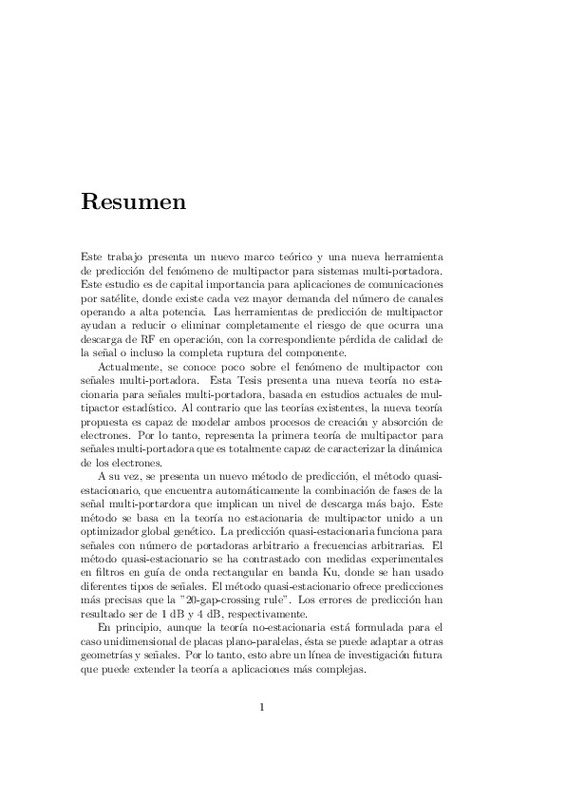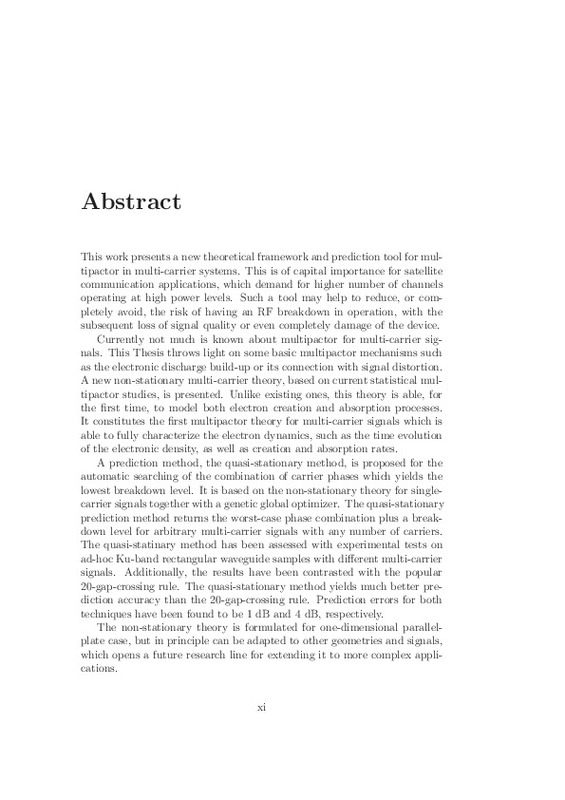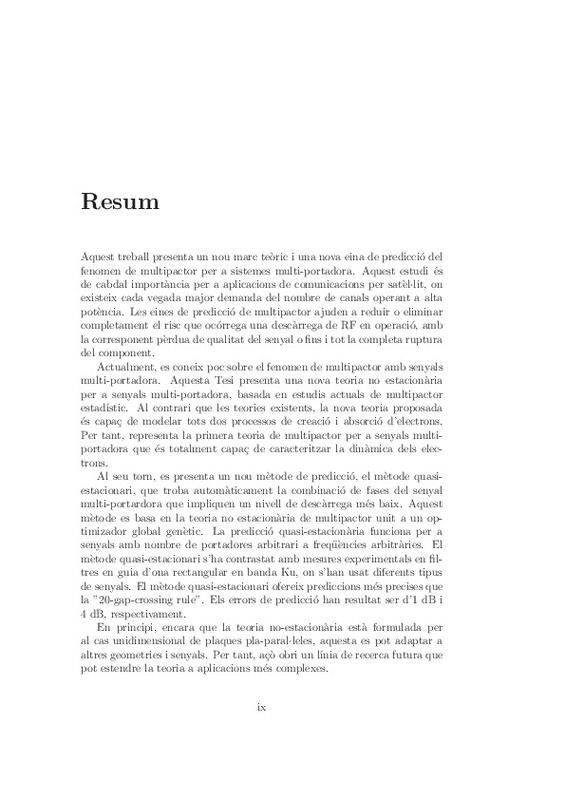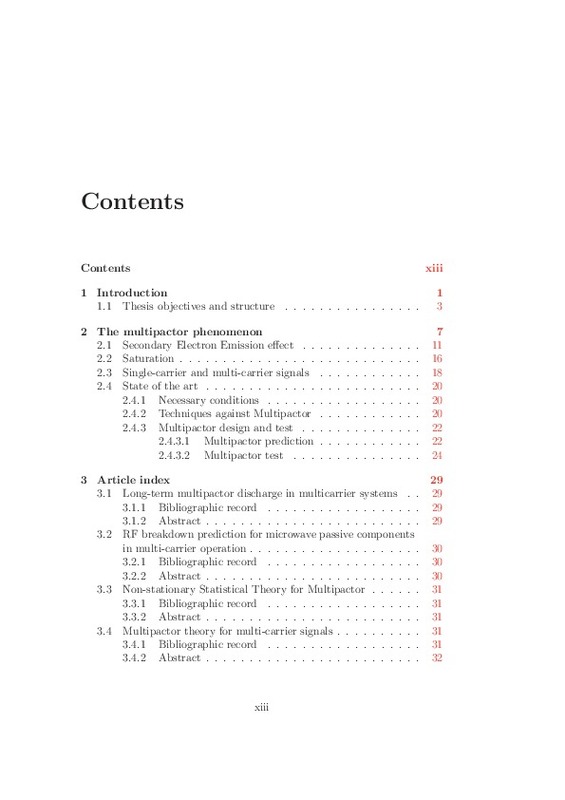- RiuNet repositorio UPV
- :
- Investigación
- :
- Tesis doctorales
- :
- Ver ítem
JavaScript is disabled for your browser. Some features of this site may not work without it.
Buscar en RiuNet
Listar
Mi cuenta
Estadísticas
Ayuda RiuNet
Admin. UPV
Multipactor in Multicarrier Systems. Theory and Prediction
Mostrar el registro sencillo del ítem
Ficheros en el ítem
| dc.contributor.advisor | Boria Esbert, Vicente Enrique
|
es_ES |
| dc.contributor.advisor | Gimeno Martinez, Benito
|
es_ES |
| dc.contributor.advisor | Vicente Quiles, Carlos Pascual
|
es_ES |
| dc.contributor.author | Anza Hormigo, Sergio
|
es_ES |
| dc.date.accessioned | 2014-07-14T08:29:53Z | |
| dc.date.available | 2014-07-14T08:29:53Z | |
| dc.date.created | 2014-06-27T09:00:44Z | es_ES |
| dc.date.issued | 2014-07-14T08:29:50Z | es_ES |
| dc.identifier.uri | http://hdl.handle.net/10251/38761 | |
| dc.description.abstract | This work presents a new theoretical framework and prediction tool for multipactor in multi-carrier systems. This is of capital importance for satellite communication applications, which demand for higher number of channels operating at high power levels. Such a tool may help to reduce, or completely avoid, the risk of having an RF breakdown in operation, with the subsequent loss of signal quality or even completely damage of the device. Currently not much is known about multipactor for multi-carrier signals. This Thesis throws light on some basic multipactor mechanisms such as the electronic discharge build-up or its connection with signal distortion. A new non-stationary multi-carrier theory, based on current statistical multipactor studies, is presented. Unlike existing ones, this theory is able, for the first time, to model both electron creation and absorption processes. It constitutes the first multipactor theory for multi-carrier signals which is able to fully characterize the electron dynamics, such as the time evolution of the electronic density, as well as creation and absorption rates. A prediction method, the quasi-stationary method, is proposed for the automatic searching of the combination of carrier phases which yields the lowest breakdown level. It is based on the non-stationary theory for singlecarrier signals together with a genetic global optimizer. The quasi-stationary prediction method returns the worst-case phase combination plus a breakdown level for arbitrary multi-carrier signals with any number of carriers. The quasi-statinary method has been assessed with experimental tests on ad-hoc Ku-band rectangular waveguide samples with different multi-carrier signals. Additionally, the results have been contrasted with the popular 20-gap-crossing rule. The quasi-stationary method yields much better prediction accuracy than the 20-gap-crossing rule. Prediction errors for both techniques have been found to be 1 dB and 4 dB, respectively. The non-stationary theory is formulated for one-dimensional parallelplate case, but in principle can be adapted to other geometries and signals, which opens a future research line for extending it to more complex applications. | en_EN |
| dc.language | Inglés | es_ES |
| dc.publisher | Universitat Politècnica de València | es_ES |
| dc.rights | Reserva de todos los derechos | es_ES |
| dc.source | Riunet | es_ES |
| dc.subject | Multipactor | es_ES |
| dc.subject | Multiportadora | es_ES |
| dc.subject | Predicción | es_ES |
| dc.subject | Filtros | es_ES |
| dc.subject | Microondas | es_ES |
| dc.subject | Alta potencia | es_ES |
| dc.subject | Descarga | es_ES |
| dc.subject | Vacío | es_ES |
| dc.subject | RF | es_ES |
| dc.subject | Plasma | es_ES |
| dc.subject.classification | TEORIA DE LA SEÑAL Y COMUNICACIONES | es_ES |
| dc.title | Multipactor in Multicarrier Systems. Theory and Prediction | |
| dc.type | Tesis doctoral | es_ES |
| dc.identifier.doi | 10.4995/Thesis/10251/38761 | es_ES |
| dc.rights.accessRights | Abierto | es_ES |
| dc.contributor.affiliation | Universitat Politècnica de València. Departamento de Comunicaciones - Departament de Comunicacions | es_ES |
| dc.description.bibliographicCitation | Anza Hormigo, S. (2014). Multipactor in Multicarrier Systems. Theory and Prediction [Tesis doctoral]. Universitat Politècnica de València. https://doi.org/10.4995/Thesis/10251/38761 | es_ES |
| dc.description.accrualMethod | TESIS | es_ES |
| dc.type.version | info:eu-repo/semantics/acceptedVersion | es_ES |
| dc.relation.tesis | 7813 | es_ES |
Este ítem aparece en la(s) siguiente(s) colección(ones)
-
Tesis doctorales [5389]






